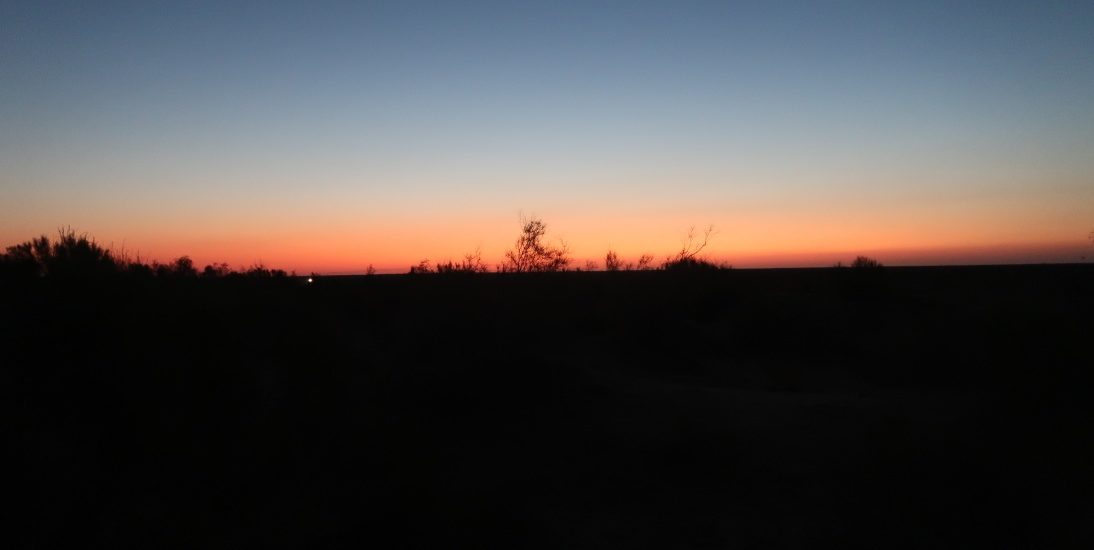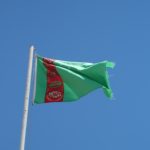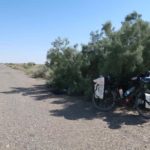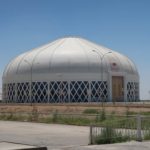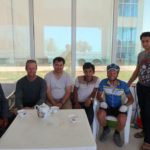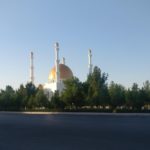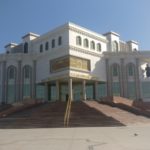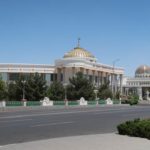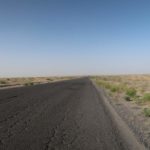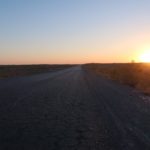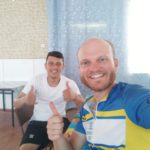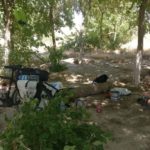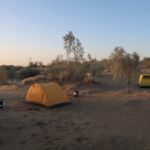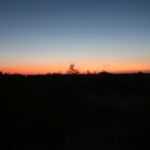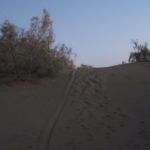The sound of the wind blowing in my ears drowns out all other audible impulses. Looking around, I’m surrounded by an arid landscape populated by low shrubs and the occasional dust devil blown up by the wind. My throat is screaming at me to drink, but the hot water in my bottles has failed to squelch my thirst for the last hour. The wind is so warm it actually transfers heat to my cheeks. Evaporating sweat is the only for my body to cool down. The heat beats down relentlessly, I feel like a bag of water trapped in a sauna & microwave combo desperately trying to keep cool.
We’ve only been four hours in Turkmenistan and already the heat has gotten the better of me and Willem. We decide to pause for the worst of the heat to pass. This afternoon pause to escape the heat would be a recurrent theme well into Uzbekistan. Lying in the shade of a desert shrub, my body continues the sweat profusely. If this is a precursor for the next five days, it’s going to be hell I say to myself while I crawl a bit deeper under the shrub looking for more shade.
The desert dash: 500kms in five days through Turkmenistan
The desert dash is notorious among silk road cyclists traveling between Iran and central Asia. It involves crossing 500kms through one of the hottest and driest deserts on earth in the little-known totalitarian country of Turkmenistan, between Serakhs and Farap. The Karakum desert holds the record for the highest recorded temperature in the former Soviet Union: 50.1 C. Winds can pick up at any time and once they start, they don’t stop until the sun goes down. Often winds gusts slow your progress to a crawl, while filling your cavities with sand particles. And all of this has to be accomplished on a five day transit visa.
So why on earth would you put yourself through this? On a bicycle? During mid summer in the first week of July? Mostly because I like a challenge. I figured I will probably not enjoy it very much while I’m at at, but looking back it would be one of the most unique experiences of my trip. Also, the only alternative – that doesn’t involve flying – is a three day ferry trip from Azerbaijan to Kazakhstan. Having reached Mashhad the week before I didn’t want to travel all the way back to Baku to catch a ferry.
I did however almost step onto a plane to Tashkent, as for a long time it looked like my application for a transit visa would be rejected. But a mere twelve hours before the visa would start, the clerk at the Turkmen embassy in Mashhad handed me my passport with a green 55 USD piece of paper glued into it. I had applied in Teheran three weeks prior and again in Masshad five days before. Having received my visa, I was trembling with anticipation for the adventure ahead. But at the same time I also felt trepidation as I knew it would be a ride where I’d likely reach my limits. I’d hope to exceed them somehow.
Day 0: Mashhad to Sarakhs
Having received the Turkmen visa at noon on the day before our entry date (July 1st), there remained only twenty hours to reach the border crossing the next morning. We decided that we didn’t want to start Turkmenistan exhausted, so we took to train to cover the 200kms to Sarakhs instead. It is the first time that I didn’t cycle a portion of my overland itinerary, but apprehensive of what was to come I felt like it was a good decision (I still do, two weeks later). We arrived at the station at 21:30 and cycled one hour into town. Grabbing a late dinner, we checked into the down town abryshem hotel for 900 000 rial (10.5 EUR at the time). Sleep came difficult, with anxiety for the next few days keeping me awake. We could actually sleep in, as the border didn’t open until 8 the next morning. We set the alarm for 6.
Day 1: crossing the border and a shortcut through the desert
The Iranian border process went more smoothly than I had anticipated. They did scan all of our panniers, but after a little hour we got our exit stamp and were free to cycle through the no man’s land to the Turkmen border control. The building was deserted when we arrived and we were greeted by air conditioning (already the temperature was rising) and young, cheerful Turkmen soldiers which – I assume from their age – were in the process of their military service. Immediately it becomes apparent that you have left Iran and entered (central) Asia, as the Turkmen people have a lighter complexity and narrower eyes.
Having seen the doctor and paid our 14 USD entry fee, we ended up waiting more than an hour to clear customs. The border officers and the soldiers were all very friendly though. I, however, was keen to start pedaling as the clock was ticking and the sun was rising. After putting the panniers through the scanner and thoroughly going through my medication (paracetamol, prufen and anti-allergy meds were no problem; more strong stuff with codeine they don’t like), I finally cleared customs around 11 o’clock. Already 11 hours of the visa had passed and we had covered naught kms… The border at Farap with Uzbekistan actually closes around 8 in the evening, so you lose another four hours of the visa. A border officer warned us that overstaying our five days would mean big problems (usually a hefty fine or deportation awaits you). Eager to get going, we set off to the Turkmen border town of Serakhs.
In Serakhs, we changed dollars to the local currency of Manat (at 17 manat per USD) and got a few cold drinks. In Serakhs we also have a decision to make: do we follow the sealed road or do we take the shortcut to Hauz Han? It is the only notable routing choice you have to make in Turkmenistan, as the rest of the route there is only one road. The sealed road is said to have a better road surface (and possibly more services), whereas the shortcut is a good 30km shorter but the road surface is worse. Having noticed the brutal headwind already, we decided to take the shortcut. The wind would slow us down so much that dodging whatever the road surface threw at us shouldn’t pose too great of a challenge. My advice is to take the sealed road if you are expecting to cycle quickly (e.g. no wind or tail wind).
The rest of that afternoon I have written down in the first two paragraphs above. It was a brutal introduction to the desert conditions in Turkmenistan. Along the way I made the mistake of trying to cool myself down in a small lake (it’s not a fata morgana, there is actually water here!) laying invitingly next to the road. It turned out this water was very saline and chaffing occurred for the rest of the day and the day after. I didn’t get a chance to rinse the salt away until the next day in Mary. Definitely a hard no: do NOT refresh yourself in said lake. After our break under the shrubs, we continued cycling. Twenty kilometers of ‘road’ (gravel with rocks, mostly) facing west offered a much welcomed reprieve from the head wind.
By this time, I was strongly longing for anything cold to squelch my thirst. I saw a gas station on the map near Hauz Han and with over 50km to go I was determined to make it before setting up camp for the night. That this would involve night riding over this horrible road did not deter my determination in the slightest. To our great surprise (and relief) there was a mini market 20km before Hauz Han that sells cold water and cola. It was by far the best cola of my life. Also they had ice cream. I felt like I had died and gone to heaven. They even offered us a plate of food and a place to stay for the night. Fearing our rest would be interrupted we preferred to camp in the sand next to the road instead. It turned out to be a miserable night: much too hot and too short to adequately recover from the day’s efforts. We rode until sunset that day and covered 81.5km in just under six hours of riding. I added the mini market to Openstreetmaps by the way :).
Day 2: headache and cycling to Mary
The next morning we set our alarms for 4:30 and, after a breakfast of biscuits, were on the road just as the sun rose (by 5:30). I woke up with a headache, probably due to dehydration, as I ended up sweating most of the night. The 10 liter of fluids the day before appeared to be insufficient. We discovered that the early morning was the best time of day to cycle: the temperature had yet to rise and the wind still sleeping as well. Feeling miserable after just 90 minutes of riding, we took a break and I ate my two bananas from Iran and drank lots of water. Slowly the headache began to fade. Having slept so badly I was feeling dead tired that morning (only day 2, oh no!) and I had problems keeping awake on the bicycle during these early hours. This reminded me of cycling home during my student times in the early mornings after a night’s out: dead tired and slightly intoxicated. In Turkmenistan the only intoxication so far could have come from eating too much sand. Though after a month with no beer in Iran, I was looking forward to a refreshing (non Islamic) beer. Just not at that very instant.
Some twenty kilometers before Mary we passed by the world’s largest yurt (or so they claim). After having downed a couple of cold drinks in a market, we got talking to the shop keeper. It turned out the shop was open for just one day (lucky us!). His English was surprisingly good and we talked about life as a merchant in Turkmenistan. He invited us to share lunch: a meat broth with onions served with bread. He owned a shop selling sun glasses and other products, which he imports from Dubai. Trying to inform after problems with customs for importing goods into Turkmenistan, he said it was not a problem at all and the Turkmen customs did not suffer from graft. Whatever the case, his shop was very well stocked indeed.
Arriving in Mary, we were both in need of a good night’s sleep. The magnificent hotel Mary was a bit over our budget, so we stayed at the Margush hotel instead. At 40 USD for a night it was the most expensive accommodation of the trip so far, but I was very happy to be out of the heat and to treat myself to sleep in an air conditioned building. Apart from accommodation, you also get a sense for the Turkmen construction style in Mary: lots of white and gold, big facades, marble everywhere, impressive structures. It is reminiscent to the age of baroque in Europe. The regime knows how to impress their people. After a decent meal in a nearby cafe and a swift bicycle chain maintenance, I went to bed early as we intended to leave early. On day two we covered 89kms in just under six hours (moving time). We didn’t cycle in the afternoon.
Day 3: Mary – Ucajy
Today we were on the bicycle one hour before sunrise. The first three hours we rode east. This meant little wind and we made good progress: 50 kms in under three hours. This section of the route is developed with farm lands next to the roads. It’s only until 30 km after Bayramaly when you enter the desert again. The rest of the morning was fairly uneventful, cycling through the desert with head winds. We covered 100kms before stopping for our afternoon siesta at a road side cafe with air conditioning. Ah, bliss.
Just before we stopped a kind man working on a nearby gas pipeline offered us a melon. The cafe offered a very limited selection of drinks, but they were cold so I’m not complaining :). We spent most of the afternoon in some trees next to the cafe however, after the guy running the place started practicing his karate and things got a little weird. We cooked lunch and spend four hours hiding from the heat under the trees. During this time a Turkmen truck driver pulled over and showed us pictures of his impressive bicycle collection (which included an Italian Colnago, or so he claims). He told me he has been the Turkmen road racing champion some twenty years ago. I’m a bit skeptical, but decide to keep my doubts to myself. I didn’t see any road bikes during my five days in Turkmenistan, I did see a horse/bicycle race track however. So maybe there’s some road racing to be had here.
After our siesta, we cycle for another hour an half before stopped for dinner in a cafe in Ucajy. It’s strange to find a town here, in the middle of the desert. But it has two cafes, lots of houses, a school and even a hotel. We decide to camp however and having pitched only my inner tent with both doors open, I manage to get some sleep.
Day 4: Ucajy – 30kms before Turkmenabad
The next morning sees us rise early again and we are packed and on the bike by 4:55. Cycling the hour before sunrise means we have to put on our lights and our fluorescent jackets, but it is by far the best time of day to cycle. You also catch a stunning sun rise this way. The landscape is just plain desert and gets very repetitive, very quickly. Truck drivers stop and offer us water occasionally. COLD water, ah it’s so nice. We also buy frozen water whenever we can. I find that if I hide this ice bottle from the sun wrapped in cloth in the middle of my rear pannier, it remains solid for a long time. Mixing it with my hot water, provides me with a source of cool water.
After a while the wind picks up and the mental game starts again: breaking up the ride into manageable sections, looking forward to the next stop (usually a cafe), keeping up a sustainable pace, trying to fight the wind, accepting that you cannot change the wind, going with the wind (if it gusts, just wait for it go down or shift down; but keep the same effort level), putting in the time on the bicycle (exchanging time for distance) and trying to cover most of our daily distance before the afternoon siesta. We cover a little under 90km before the siesta.
We spend the afternoon in a road side cafe together with road workers who are having their lunch here. Pleased to be out of the sun, we take naps, buy drinks and food from the cafe and converse with the workers. After a five and a half hour break, we cycle only another half hour before pitching our tent early in the desert next to the road. This provides us with ample time to cook and eat something before going to sleep.
Day 5: Turkmenabad and crossing the border to Uzbekistan
On our last day we are again on the bicycle before 5 am. The 30kms to Turkmenabad pass quickly and we ride through a big arch into the outskirts of the city. Wanting to film our desert exit, I film our entrance under the arch. But a police officer hails me over and orders me to delete the film. Not wanting any trouble, I quickly oblige and we pedal off towards the city. We first passed a lot of farm land, before we entered the city properly. The main highlight for me here was the big market going on (we were there around 8 in the morning) with fresh fruits and veggies. We spend all of our remaining manats here on apples, bananas and were offered fruit as well. Many locals eyed us curiously and some hailed us down for a talk. As always this involves saying where I am from, how old I am, where I am heading and whether or not Turkmenistan is a good country. I don’t mind, I’m happy to have made it through the desert and will gladly answer any questions.
After a break, we pedal the last hour and a half to the border crossing near Farap. The road takes a big detour to get here, but we reach the border just before 11 o’clock in the morning. It’s much busier here than in Serakhs, but tourists are giving priority and we manage to skip all the lines. The luggage scanner is not working at the Turkmen customs so instead they hand search some of our bags. The customs officer asks if I am carrying any pistols or kalashnikovs, I smile and answer no. Why would I need those? I felt very safe in Turkmenistan actually. We exit Turkmenistan with well over 12 hours on our visa remaining. The Uzbek border control is a breezy by comparison. We again get a temperature scan from a guy wearing a white coat, but there is no customs check and we are quickly on our way to Alat. Where we change money, hang out at a mini market stuffing ourselves and check in to a hotel.
We made it, we completed the desert dash. It felt like a great accomplishment. Looking back the first day was the toughest, our siestas on other days meant we could escape the worst of the heat. The problem is that on the first day you have to cross the border, which means you loose the whole morning. It was a rough ride, but unique in many ways. Those are five days I will remember for a long, long time.
P.S.: it turned out Uzbekistan is as hot as Turkmenistan. But in Uzbekistan there are no long stretches of nothing and I have a thirty day visa instead of five days!
